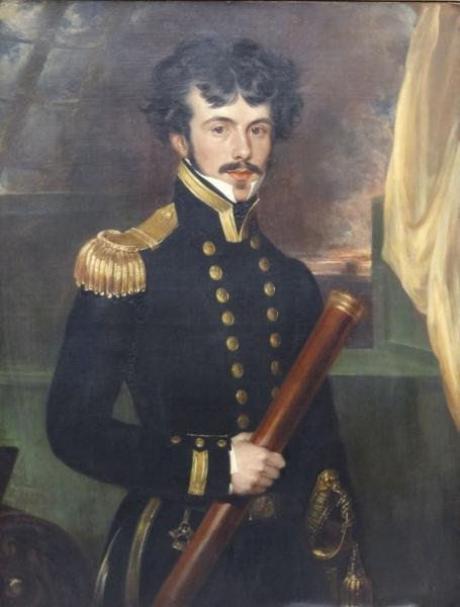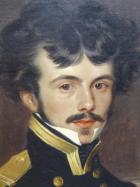signed " W Derby Pxt" and further inscribed on a label on the reverse "Charles Richardson"
This portrait of an Officer of the Bombay marine is thought to be Vice Admiral Sir Charles Richardson who was painted when he was a Captain serving in the Bombay Marine. Vice-Admiral of the White Sir Charles Richardson, K.C.B., joined the Royal Navy as Captain's Servant in H.M.S. Vestal (Captain R.J. Strachan), November 1787; after accompanying an embassy to China he removed with Strachan to H.M.S. Phoenix 36 guns and 'was present, 19 Nov. 1791, while cruising off the Malabar coast in company with the Perseverance frigate, in an obstinate engagement (produced by a resistance on the part of the French Captain to a search being imposed by the British upon two merchant vessels under his orders) with La Résolue of 46 guns, whose colours were not struck until she had herself sustained a loss of 25 men killed and 40 wounded, and had occasioned one to the Phoenix of 6 killed and 11 wounded. While on the East India station Mr. Richardson was for several months employed in the boats in co-operating up different rivers, with the army under Sir Robert Abercromby in its operations against Tippoo Saib' (O'Byrne refers); having attained the ranks of Midshipman and Master's Mate and having fought with H.M.S. Royal George in Lord Howe's actions of 29th May and 1st June 1794, Richardson was appointed Lieutenant in H.M.S. Circe (Captain P. Halkett), August 1794 - 'of that frigate he was First-Lieutenant during the great mutiny at the Nore; where his exertions in preventing the crew from acquiring the ascendancy gained him, in common with his Captain and the other officers of the ship, the thanks of the Admiralty. The Circe forming one of Lord Duncan's repeaters in the action off Camperdown 11 Oct. 1797, Lieut. Richardson on that occasion achieved an important exploit. Fearing lest the Dutch Admiral, De Winter, after his own ship had been dismasted and silenced, should effect his escape on board some other, he volunteered to go in an open boat and take him out. Succeeding in his object he had the honour of presenting him in person to the British Commander-in-Chief [Admiral A. Duncan]; who in consequence received him on promotion in Jan. 1798 on board his flag ship the Venerable 74, and made him, 6 March following his Signal Lieutenant in the Kent 74 (Captain W.M. Hope)' (O'Byrne refers); The following year Richardson was sent with the expedition to Holland, where he commanded a division of seaman, attached to the army under Sir Ralph Abercromby, from the period of the debarkation near the Helder until the surrender of the Dutch squadron under Admiral Storey; with the conclusion of the expedition Richardson was ordered home in charge of a Dutch 68 gun ship; after assisting Abercromby again, this time in Egypt, he removed to H.M.S. Penelope (Captain the Hon. H. Blackwood); nominated Acting-Commander H.M.S. Alligator 28 guns, armée-en-flûte, July 1802, 'While in that ship, to which he was confirmed 9 Oct. 1802, Capt. Richardson directed the movements of the flotilla employed at the reduction of Demerara, Essequibo, and Berbice in 1803, and was highly spoken of in the public despatches for his exertions at the taking of Surinam in the spring of 1804 [London Gazette 1804, pp. 755, 761]. On 6 July in that year he was in consequence invested by Sir Samuel Hood with the command of the Centaur 74, the ship bearing his broad pennant, an act which the Admiralty confirmed 27 Sept. ensuing' (O'Byrne refers); Richardson returned to England in March 1805; appointed to H.M.S. Caesar (bearing the flag of his old friend and patron Sir Richard J. Strachan), January 1806; he was employed in the latter off Rochefort and subsequently in the Mediterranean, 'On the 23d Feb. 1809, the Caesar, then bearing the flag of Rear-Admiral Stopford, but still commanded by Captain Richardson, assisted [with the Defiance and the Donegal] at the destruction of three French frigates in the Sable d'Olonne, and on that occasion sustained considerable damage in her bowsprit and rigging, by the fire from several batteries under which they had sought refuge' (Royal Naval Biography, Marshall refers); served with Strachan in the expedition to the Scheldt, during which the town of Camvere offered it's surrender to Richardson, him being the senior naval officer on shore present; terms were agreed with him and Lieutenant-General Fraser, 'During the investment of Flushing he landed at the head of a brigade of seaman, and commanded a battery of six 24-pounders with much effect. His services throughout the operations were so important and his zeal and bravery so very conspicuous that he elicited the public praise of the Earl of Chatham, the Military Commander-in-Chief, and the high approbation of Lieutenant-General Sir Eyre Coote, who conducted the siege, and of Major-General McLeod, commanding officer of the Royal Artillery [Sir Richard J. Strachan's Despatches, 4.8.1809 and 16.8.1809, London Gazette 1809, pp. 1233, 1322]' (Ibid); Richardson exchanged into the frigate Semiramis, for service off Lisbon, April 1810; whilst serving with the latter in company with H.M.S. Diana (Captain W. Ferris) at the mouth of the river Gironde, 25.8.1811, they discovered 4 sail under the escort of a brig of war, the Diana accounted for the Teazer (formerly a British vessel) whilst Richardson succeeded 'in driving on shore, and burning under the guns of the batteries at Royan, Le Pluvier national brig of 16 guns and 136 men' (O'Byrne); the Semiramis suffered only 3 wounded, and Richardson received the thanks of the Admiralty (London Gazette 1811, p.1752); Richardson captured a large number of prizes, including the Grand Jean Bart privateer of 14 guns and 106 men; the Semiramis was paid off 29.8.1814, and Richardson was shortly after nominated a C.B. 'as a reward for his meritorious conduct during a period of more than twenty-six years, passed in active service at sea and co-operation with troops on shore in every quarter of the globe'; after three years with H.M.S. Leander Richardson was appointed to H.M.S. Topaze, 'and proceeded in her from Pulo Penang to China, where 14 of his crew were dangerously wounded by the natives, while employed filling water at Lintin.... Two Chinese having been killed by the Topaze's fire, disputes ensued with the authorities at Canton, which led to the suspension of all commercial intercourse, the embarkation of the British factory without passes, and the departure of all the Hon. Company's ships lying in the Tigris. At length, however, a Mandarin of high rank was sent on board the frigate to discuss this unpleasant affair; and he proving a sensible and moderate man, the business was satisfactorily adjusted, and matters restored to their former footing, in the spring of 1822' (Marshall refers); Richardson was invalided to the Cape of Good Hope in the same year; Rear-Admiral 1837 (K.C.B. 1841); Vice-Admiral of the White, December 1847. His prizes will have made him a wealthy man. Certainly he bought the estate of Painsthorpe Hall, East Yorkshire where he died, aged 81 in 1850. It is clearly a beautiful place. William Derby, an English miniature painter and copyist, was born in 1786, at Birmingham, where he received instruction from Joseph Barker. In 1808 he came to London and executed drawings for the 'Stafford Gallery,' and in 1825 for Lodge's 'Portraits.' He also made copies of ancestral portraits for Lord Derby. In 1838 he was struck with paralysis, but was able to continue work till his death in 1847. There are two watercolour drawings by him in the South Kensington Museum: 'A Fisherman,' and 'A Man holding a book.' He painted a number of naval portraits, the most important being a portrait of the British Naval officer and Artic explorer Rear Admiral SirJohn Franklin.
Derby was born in Birmingham on 10 January 1786, where he was taught drawing by Joseph Barber. In 1808 he moved to London, where he began his career by making the reduced drawings for the plates of the Stafford Gallery, a set of engravings of the paintings in the Marquess of Stafford's collection, published in four volumes in 1818 with text by William Young Ottley and Peltro William Tomkins.
He then pursued a career as portrait and miniature painter, occasionally making watercolour copies of notable pictures, until 1825, when he succeededWilliam Hilton, R.A., in making the drawings for Lodge's Portraits of Illustrious Personages of Great Britain, completed in 1834. This involved copying paintings in collections throughout the country, and in the course of his work Derby obtained many useful introductions. Among his patrons was the Earl of Derby, whose portrait he painted, and who commissioned him to make watercolours after the portraits of his ancestors, from the reign of Henry VII onwards, which existed in various collections. In 1838 a severe attack of paralysis deprived him of speech and the use of one side of his body, but in a few months he had recovered sufficiently to continue his work, which he did with the assistance of his son, Alfred Thomas Derby.
In an obituary of Derby, the sculptor Peter Hollins singled out his copy of Landseer's Return from the Highlands, as one of his best works:
[Landseer's] picture is among the choicest productions of this highly-gifted master. The copy is also a gem: the elegance of the drawing, the deep sentiment of the work, and the various textures and local colours, are given with a fidelity and beauty truly astonishing.
Hollins added:
It has been a great advantage to the world of art, when fine original pictures have been inaccessible to the engraver, to have copies made by an artist of the powers possessed by Mr. Derby, who, while he attended with the greatest care to the most minute accessories, caught the spirit and character of each particular master he undertook to imitate. As an artist, he possessed powers of a great range in oil and water-colour painting, as is abundantly attested by his numerous portraits, miniatures, vigorous original subjects of still life, and his exquisite water-colour copies, over which he threw a peculiar charm.
A portrait in oils by Derby, Lady Adelaide Georgiana Fitzclarence as a Child is at Petworth House.
Between 1811 and 1842 he exhibited 49 works at the Royal Academy, 16 at the British Institution and 15 at the Society of British Artists. They included portraits in oil, still lifes, and miniatures. He died in Osnaburgh Street, London, on 1 January 1847, survived by his widow and eight children.



